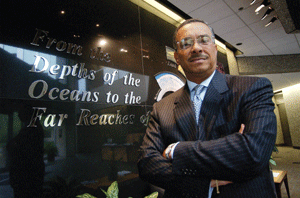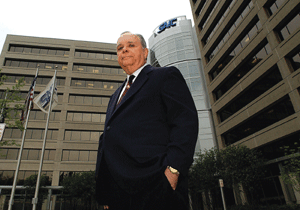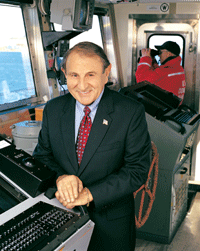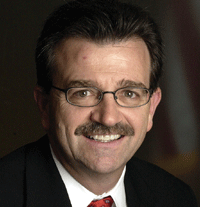11th annual Top 100

If you want to be a top dog in the federal IT market, you've got to act like one. That's the lesson from the rising stars on Washington Technology's <b>2004 Top 100</b> list. We talk with the Top 100's established players and steady climbers to uncover the latest trends, biggest opportunities and secrets for growing a federal business. <br><a href="http://www.washingtontechnology.com/news/19_3/special-report/23418-1.html">? Overview story</a><br><a href="http://www.washingtontechnology.com/top-100/2004/">? The List</a>

To prepare for its next phase of growth, Stanley Associates Inc. reorganized and developed a new strategic plan. "We had to change," said CEO Philip Nolan.
Henrik G. de Gyor

At his first board meeting with investors, SI International's Ray Oleson was asked, "What are you going to be when you grow up?"
Henrik G. de Gyor

"We want systems in place that are capable of handling a business two or three times the size we are now." ? Mac Curtis, Pearson Government Solutions Inc.
David S. Spence

Sydney Martin has declined offers from larger integrators to buy the Sytex Group. "I'm not ready to bow out and say the heck with it," he said.
Olivier Douliery
The Top 100's steady climbers have one thing in common: a long-term growth plan
By Nick Wakeman Arthur Johnson, Lockheed Martin's senior vice president of corporate strategic development, said one of the company's biggest challenges is finding qualified technology workers with government security clearances. ----- Lockheed Martin Corp. Olivier Douliery By Roseanne Gerin Steve Carrier, vice president of business development and strategic planning at Northrop Grumman's IT division, said he sees growth in the company's homeland security work. ----- Northrop Grumman Olivier Douliery Austin Yerks, president of business development for CSC's federal-sector unit, said the company is well positioned to take advantage of the military's transformation initiative. Computer Sciences Corp. Henrik G. de Gyor "We need to balance the need for security with the need for throughput. You cannot inspect every container. We have to ensure safety while allowing commerce to occur."? Shephard Hill of Boeing Integrated Defense Systems, on its role in Operation Safe Commerce, a pilot program to improve seaport security. Boeing Co. J. Adam Fenster Duane Andrews, president and COO of SAIC's federal business, said that the company's 35 years of service to military and civil agencies has given SAIC a "deep domain knowledge" of customer needs. Science Applications International Corp. Olivier Douliery "There's a whole generation of combat and civilian leaders now that want more IT or information systems to support them," said Gerald DeMuro of General Dynamics. Henrik G. de Gyor With Ron Ross leading Raytheon Co.'s Information Systems unit, the company is chasing five opportunities worth more than $2 billion. "We're in the game now," Ross said. Raytheon Co. Olivier Douliery Despite some rough patches, "EDS is vibrant. Our best days are ahead of us," said Al Edmonds, vice president of global sales and client solutions for EDS' U.S. Government Solutions unit. EDS Corp. File photo "This is something being designed specifically for the war on terror. It can deliver special forces into places where big ships can't go." ? Gene Ray, Titan CEO, on the X-Craft, a high-speed, 260-foot catamaran designed to travel at speeds of more than 50 knots that Titan is building for the Navy. Titan Corp. File photo "We want to raise our reputation on implementation to the same level that we enjoy on consulting." ? Al Picarelli, senior vice president and head of Booz Allen's Defense Systems Team. Booz Allen Hamilton Inc. Olivier Douliery Anne Altman,managing director of IBM's Bethesda, Md.-based federal unit IBM Corp. Walt Havenstein, executive vice president of BAE Systems BAE Systems North America Inc. Tom Buchsbaum, vice president of Dell Federal Systems Dell Inc. Frank Lanza, chairman and CEO L-3 Communications Corp. John Spotila, president and chief operating officer of Chantilly, Va.-based GTSI. GTSI Corp. Robert Henry, corporate senior vice president and president of Harris' Government Communications Systems Division: "If you want to be big, you have to act big." Harris Corp. Prime IT contracting revenue: $521,600,000 L. Kenneth Johnson, CACI's president of U.S. operations CACI International Inc. Martin Faga, Mitre's president and chief executive officer Mitre Corp. Prime IT contracting revenue: $469.6 million Joseph Kampf, president and chief executive officer Anteon International Corp. Lou Addeo, AT&T Government Solutions president AT&T Corp. Prime IT contracting revenue: $458.8 million When Philip Nolan went to work for Stanley Associates Inc. in 1989, communication was swift and easy for the 20 employees who sat at desks just outside the offices of the company's two owners.
When Philip Nolan went to work for Stanley Associates Inc. in 1989, communication was swift and easy for the 20 employees who sat at desks just outside the offices of the company's two owners.
"When I had an idea, I just had to shout,'Hey, boss,'" said Nolan, who began as a program manager.
Times have changed for the Alexandria, Va., company, which now has more than 1,500 employees spread across dozens of offices worldwide. During a strategic planning session last year, employees complained that communication had become a one-way street that flowed from the executives to the rest of the company. One employee drew lightning bolts in a picture to describe the way the company communicates.
"Sure, my feelings were hurt. I want everyone to be happy," said Nolan, the company's president and chief executive officer. "You kind of take for granted that everyone knows what you know, because they all used to know what you know."
Many companies on the 11th annual Washington Technology Top 100, which ranks government IT contractors by federal prime contracting revenue, share Stanley Associates' growing pains. These companies often enter in the lower ranks of the list and push their way up year after year as they grow.
Stanley Associates first appeared in 2002 at No. 76. Last year, the company was ranked at No. 64, and this year it reached No. 52 with $136.8 million in prime contracting revenue. Rankings are based on an analysis of procurement data by Federal Sources Inc., McLean, Va.
Others that have made similar climbs over the past several years include Sytex Group Inc., Pearson Government Solutions Inc., ITS Services Inc./SEA Inc. and SI International Inc.
How these companies handle the problems and issues of growth can determine just how fast and how far they will grow, industry experts said.
At Stanley Associates, Nolan moved to rectify the company's communications problem by appointing a director of communications to make sure the company's message is articulated clearly to the staff and the customers, and that someone is making communications flow in both directions at the company.
Still, many small business executives are reluctant to tamper with the organizations and procedures that have brought them success. Understandably, they want to keep the positive aspects of a small company, such as the close-knit office environment.
But if executives want their companies to grow, they must establish a clear vision or strategy for achieving that goal, experts said. They also must put into place an infrastructure that anticipates growth and change. And they must know the answer to the question: Are you a buyer or a seller?
THE VISION THING
Ray Oleson recalls vividly the questions asked by investors at SI International's first board meeting.
"They wanted to know, 'What are you going to be when you grow up?' " said Oleson, 59, who came out of retirement in 1998 to launch SI with the backing of Chicago investment firm Frontenac. He is SI's chairman and CEO.
[IMGCAP(2)]Being forced to think like that from the beginning was critical to SI's development, he said. The company's growth would have been more happenstance, Oleson said.
The Reston, Va., company cracked Washington Technology's Top 100 in 1999 at No. 99, then rose to No. 85 in 2002, No. 83 in 2003 and No. 66 this year with $102.1 million in prime contracting revenue.
"Defining our plan up front allowed us to make a short list of the kinds of companies we wanted to purchase and what kinds of customers to go after," he said. "It created a road map for everyone to follow."
Having that road map is critical as a company grows, said David Langstaff, who was president and CEO of Veridian Corp. Through acquisitions and organic growth, he led that company to more than $1 billion in annual revenue before General Dynamics Corp. bought it last year.
"The challenge is to be constantly looking out five or six years and seeing what and who you'll be," Langstaff said.
Looking forward is important, because a company changes as it grows. There's a risk that senior leadership will lose its focus, and growth will stagnate.
"That's the big pitfall. Companies don't think about what the next stage is and how they'll get there," he said.
'OVERDESIGN YOUR SYSTEMS'
Even before making his first acquisition as CEO of ITS Services Inc., Todd Stottlemyer and his team were laying the groundwork to expand the then-$100 million-a-year company. ITS Services of Springfield, Va., was rising on the Top 100 when Stottlemyer led a buyout in April 2003 with the backing of Arlington Capital Partners, a private equity firm. One of his first steps was bringing in a management team that had run much larger businesses, he said.
At the top is ITS Chairman Phil Odeen, former chairman of TRW Inc. and before that CEO of BDM International Inc. Paul Leslie, ITS' president and chief operating officer, previously worked at EDS Corp., BDM, TRW and BTG Inc. Stottlemyer also worked at BDM and BTG.
"We all have experience running and growing billion-dollar businesses," Stottlemyer said.
With a new management team in place, ITS in January doubled its size by merging with Science and Engineering Associates Inc. of New Orleans. This year, the combined company reached No. 62 on the Top 100 with $109 million in prime IT contracting revenue. SEA made its first appearance on the Top 100 last year at No. 78. ITS cracked the rankings in 2002 at No. 90 and was No. 84 in 2003.
[IMGCAP(3)]ITS has integrated SEA quickly because the infrastructure was in place to support fast growth, Stottlemyer said.
Besides getting the right people, companies anticipating growth must have the necessary financial, human resources, bid and proposal and other administrative systems for supporting a larger organization, executives said.
"You have to overdesign your internal systems," said Mac Curtis, president and CEO of Pearson Government Solutions Inc. of Arlington, Va. "We want systems in place that are capable of handling a business two or three times the size we are now."
Pearson, a subsidiary of London-based Pearson plc., made its first appearance on the Top 100 at No. 75 in 2001 after it acquired National Computer Systems Inc. It rose to No. 63 in 2002, No. 60 in 2003 and No. 44 this year with $158.6 million in prime contracting revenue.
Pearson has seen its overall government revenue grow from less than $100 million when it acquired NCS in 2000 to about $350 million today, Curtis said.
In the government IT services market, where the competition for skilled employees is fierce, Pearson is constantly evaluating its human resources programs to ensure it gets the best people, Curtis said.
"We are always looking at the human resource piece and asking, are our benefits right? Are we competitive?" he said. "We spend a lot of time on that."
ARE YOU FOR SALE?
Sydney Martin started Sytex Group Inc. in his dining room. He was employee No. 1 and his wife, Sharon, who kept track of the money, was employee No. 2.
[IMGCAP(4)]From that humble start in 1988, the Doylestown, Pa., company has soared to about $290 million in 2003 with 1,400 employees. Martin said he expects to hit $375 million in revenue in 2004, not counting any acquisitions the company might make.
The company first appeared on the Top 100 in 2000 at No. 94. In 2001, the company rose to No. 77. It held steady in 2002 at No. 79 before hitting No. 51 in 2003 and No. 39 this year with $195.7 million in prime contracting revenue.
With an organic growth rate of 50 percent each of the last two years and core customers such as the Army, Navy and Air Force, Sytex has drawn the attention of much larger systems integrators looking to buy the company.
"There was a lot of money being talked about. I had to do some soul searching," Martin said.
After reviewing how fast the company was growing and the strength of the market, Martin decided the financial returns would be greater by staying independent. "I'm not ready to bow out and say the heck with it," he said.
Looking at potential returns also was part of SI International's decision to remain independent rather than be acquired, Oleson said. Because Frontenac was backing the company, Oleson said he knew from the beginning the investment group eventually would want to recoup its money and the hoped-for returns. That meant SI either would be sold to another company or would sell stock to the public.
Oleson examined both options. After filing its registration papers with the Securities and Exchange Commission for an initial public offering, the company also shopped itself to potential buyers, he said.
"The offers were much less desirable than the IPO," he said. In November 2002, SI completed its IPO and raised $53.9 million.
At Stanley Associates, hardly a week goes by without some sort of offer coming in, Nolan said. But the company, which is employee-owned and has no outside shareholders, is under no pressure to sell. The company has a strategic plan with a goal of reaching $500 million in annual revenue by 2008, so last year it reorganized to prepare for its next stage of growth, Nolan said.
Among the changes, Stanley Associates established a senior executive to track merger and acquisition opportunities, an executive to ensure that back-office systems meet expected requirements, and an account management organization dedicated to building customer relationships.
"The way we grew up, we depended on the program managers to grow the business, and that was very good to get us to this level," Nolan said. "To go from there to $500 million, that was just not a scalable model, so we had to change."
Senior Editor Nick Wakeman can be reached at nwakeman@postnewsweektech.com.
www.lockheedmartin.com
Ticker: LMT
Prime IT contracting revenue: $5.5 billion
Based: Bethesda, Md.
President and CEO: Vance Coffman
Employees: 130,000
2003 revenue: $31.8 billion
2003 net earnings: $1.1 billion
2002 revenue: $26.6 billion
2002 net earnings: $500 million
Lockheed Martin Corp. has won the No. 1 spot on Washington Technology's Top 100 for 10 years running, but company officials never rest easy. The company is still making acquisitions, chasing big IT contracts and worrying about how to find talented workers.
The Bethesda, Md., company tipped the scales with nearly $5.5 billion in federal prime IT revenue in this year's Top 100 ranking. But being top dog has its problems. The company has run into trouble with its acquisition of Titan Corp. of San Diego.
Federal investigations into allegations that some of Titan's international consultants and subsidiaries made improper payments to foreign government officials to drum up business abroad have stalled the acquisition.
As a result of the inquiries, Lockheed Martin reduced its buying price to $2.2 billion from $2.4 billion, and Titan has twice postponed a shareholder vote on the takeover. Titan has rescheduled the stockholder meeting for early June.
The matter, however, is now in the hands of the Justice Department. Lockheed Martin is requiring Titan either to receive a written exoneration from the Justice Department or enter a plea agreement and complete the sentencing process before the purchase goes forward.
Yet, Lockheed Martin is determined to get Titan, as it will add an IT contracting business rich in intelligence systems to the aerospace giant's mix of defense, space, homeland security and government IT lines.
"We agreed and desired to make this a major [project] to acquire Titan, because we felt it was the sweet spot of our business," said Tom Jurkowsky, Lockheed Martin's vice president of media relations.
When the deal is done, Lockheed Martin likely will have secured its lead in the race for federal IT contract dollars for many years to come, and placed itself beyond the reach of its closest competitor, Northrop Grumman Corp., which analysts said gained a giant step on Lockheed Martin when it acquired TRW Inc. in 2002.
In the meantime, Lockheed Martin has landed five big wins in the past year:
Lockheed Martin is competing for the Homeland Security Department's $10 billion contract for the U.S. Visitor and Immigrant Status Indicator Technology program, called U.S. Visit, to be awarded this month.
The company also is chasing a spot on the multiple-award Spirit contract coming out of DHS. The contract has a $10 billion ceiling and will have several winners in its four service areas.
Arthur Johnson, Lockheed Martin's senior vice president of corporate strategic development, said he also expects more contracts from outsourcing, "an area of interest for our customers, and an area where we will expand."
Lockheed Martin continues to keep an eye on more opportunities from DHS and the intelligence agencies with infrastructure modernization and IT security projects, said Johnson, who also coordinates the company's homeland security and IT initiatives.
Lockheed Martin reported sales of $31.8 billion in 2003, $3.2 billion of which came from its information and technology services division, one of its five business segments. Of that amount, 40 percent came from defense services, 37 percent from IT and 23 percent from NASA. Johnson said IT and technology sales generate about a quarter of Lockheed Martin's revenue, almost all of which comes from the federal government.
Cai von Rumohr, aerospace and defense analyst at SG Cowen Securities, said Lockheed Martin hasn't clearly detailed its plans for absorbing Titan. He said Lockheed Martin could face some defiance from Titan employees if the corporate cultures are incompatible.
Johnson said that the company created an integration team last autumn to determine how Titan's employees and technologies would be blended into the appropriate business areas.
Although he declined to give specifics before the merger's completion, he said the team considered all disciplines within Lockheed Martin, including legal, finance and human resources.
Last September around the same time that Lockheed Martin announced its intentions to buy Titan, the company also announced that it was acquiring the federal government IT business of Affiliated Computer Services Inc., an IT outsourcing company in Dallas, while ACS was buying Lockheed Martin's commercial IT business. The deal was wrapped up in two months.
Johnson said one of the company's major challenges is finding qualified technology workers with government security clearances. About half of the company's employees are involved in technology and engineering functions, he said.
Lockheed Martin will not disclose the number of employees with government security clearances, but the company expects to hire 10,000 to 12,000 workers annually over the next three to five years, of which about one-third will require various security clearances, said Thomas Greer, Lockheed Martin's manager of media relations and corporate communications.
www.northropgrumman.com
Ticker: NOC
Prime IT contracting revenue: $4.9 billion
Based: Los Angeles
President and CEO: Ronald Sugar
Employees: 120,000
2003 revenue: $26.2 billion
2003 net earnings: $866 million
2002 revenue: $17.2 billion
2002 net earnings: $64 million
"The biggest uptick that we're seeing now is the homeland security piece," said Steve Carrier, vice president of business development and strategic planning at Northrop Grumman's IT division. With these areas in mind, company officials said they hope for more contracts this year like the seven-year, $337 million task order the company won in April to develop a secure data network for the Homeland Security Department.
That victory, according to Carrier, followed other Northrop Grumman strategic wins over the past 12 months:
With many contracts coming from the Homeland Security Department, Carrier said the department's federal dollars will trickle down to state and local governments for first-responder contracts, opening a wider opportunity for Northrop Grumman to increase its business in that sector.
The company is positioning itself in about 12 of the nation's largest states to grab expected contracts for communications modernization projects and command and control centers, he said. State and local IT contracts accounted for $400 million of Northrop Grumman's revenue last year.
Carrier said the company's three major strengths -- its employees, its technologies and its past performance -- are key to winning contracts. He noted the importance of the company's past performance in competing for IT contracts, because up to 40 percent of the government's evaluation of prime contractors can focus on a bidder's experience.
The IT prizes that Northrop Grumman plans to bid on this year include the Treasury Department's enterprise system; the Army Knowledge Online Web portal; a large, managed-services deal for the Army Corps of Engineers; and the Army's Battle Command Training Program recompete.
The biggest defense opportunity is one of the prime contract awards for the Air Force's $10-billion Network-Centric Solutions program, called NetCents. Under the multiple-award task order contract, winners will offer IT, networking, telephony, security and voice, video and data communications solutions.
One analyst, however, said that Northrop Grumman could face difficulties in the billion-dollar contract arena, because its business lines are not unified.
Northrop Grumman is "still a collection of businesses," said Howard Rubel, an aerospace analyst at Soundview Technology in San Francisco. "It means that it's hard for them to necessarily go after some of the mega-size contracts, but this is not to say they can't compete in this area."
Carrier dismissed this criticism, saying the company has proved it can win mega deals.
Along with its many wins this year, Northrop Grumman also had four disappointing losses, Carrier said. These include a $2.5 billion Arnold Engineering Development Center contract for the Air Force; a $1.2 billion NASA Space Mission Communications contract; a $600 million Air Force Pentagon Communications Agency contract; and the Intelligence Community Engineering contract for the Air Force.
As the company moves forward, Carrier said he expects continuing challenges from Northrop Grumman's main competitor, Lockheed Martin Corp. Although Lockheed Martin's planned purchase of Titan Corp. will strengthen its capabilities in intelligence areas, Carrier said: "We're not panicking. We're just going to work harder and get tougher."
Over the past year, Northrop Grumman's IT division in Herndon, Va., has been doing just that. It generated nearly $4.8 billion, or 23 percent, of the company's total revenue in 2003. Around 92 percent of the IT sector's sales come from the federal government, while the remainder is generated by state and local government and the commercial sectors. The IT division is the second largest of the company sectors, behind Northrop Grumman's Electronics Systems unit in Baltimore.
The Mission Systems unit, which is involved in IT-heavy business such as command and control systems, pulled in $4.1 billion in 2003 revenue. Among the major wins by the Mission Systems unit were a $4 billion, eight-year missile defense contract and a $175 million contract for advanced security systems for the Air Force.
One lingering question is whether Northrop Grumman will acquire more companies to keep pace with Lockheed Martin. Its last buy was its 2002 purchase of TRW Inc.
Carrier said the company doesn't have any acquisition candidates in mind in the near term. One analyst said it might not be necessary for Northrop Grumman to make large acquisitions to grow.
Northrop Grumman is "a strong player now, but it might want to do niche acquisitions," said Cai von Rumohr, aerospace and defense analyst at CG Cowen Securities.
One major challenge for Northrop Grumman will be to fill 1,000 positions in the IT sector, especially those requiring government security clearances, Carrier said. Overall, Northrop Grumman has 6,000 vacancies to fill.
"Recruiting is the highest priority that we have now," said Carrier, who joined the company nine years ago when the IT division was created. "There's just no unemployment [in northern Virginia], so you really have to be creative in hiring these people."
?Roseanne Gerin
www.csc.com
![]() Ticker: CSC
Ticker: CSC
Prime IT contracting revenue: $4.1 billion
Based: El Segundo, Calif.
CEO and chairman: Van Honeycutt
Employees: 90,000
2003 revenue: $11.3 billion
2003 net earnings: $440.2 million
2002 revenue: $11.4 billion
2002 net earnings: $344.1 million
"The DynCorp buy recommitted CSC to the federal market," said Bob Kipps, director of Houlihan Lokey Howard & Zukin's Aerospace, Defense and Government Group in McLean, Va. "It was a bold move in a marketplace they had largely ignored. They increased their IT and homeland security presence, and positioned themselves for a lot of international growth.
"Even though their commercial business has continued to struggle, they've managed to ride out the commercial IT storm," Kipps said.
With the DynCorp buy, CSC beefed up its expertise and manpower, which underscores its ability to handle some of the government's biggest awards -- capabilities enjoyed by just a handful of its largest competitors.
Since 1994, DynCorp International has supported civilian policing missions in Europe, Asia, Africa, the Middle East and the Caribbean under the purview of a variety of international bodies, including the United Nations. Now, according to the terms of a State Department contract, worth $1.75 billion if all options are exercised, CSC/DynCorp is handling, among other duties, new-recruit training at the Iraq Police Academy.
The deal consummates the first of three planned contracts under the State Department's $6 billion Civilian Police Program, which aims to bolster international civilian-policing operations in post-conflict areas around the world.
DynCorp will compete for task orders to provide law enforcement personnel and logistics, management and construction services to support justice authorities and agencies during international peacekeeping missions and security operations.
CSC said DynCorp will recruit as many as 2,000 U.S. law-enforcement specialists to serve overseas in yearlong policing missions.
"We have 13,000 employees involved in security-related services overseas, in the Balkans, Afghanistan, Kuwait and Iraq," said Austin Yerks, president of business development for CSC's federal-sector unit. "Clearly, building the Iraq Police Academy wasn't anticipated last year. The geopolitical situation has affected us in a positive way."
Although CSC's federal business accounts for only 40 percent of its overall revenue, government-derived income continues to expand at a healthy 10 percent to 12 percent a year, according to Yerks. The company plans to bid on roughly $35 billion in anticipated awards.
Although the federal outsourcing push has languished during the war in Iraq, Yerks said he expects modest acceleration. As government's desire for modernization increases, the federal sector will continue to turn to contractors to fulfill capabilities it lacks internally.
"Major outsourcing procurements are another 12 months in the future," Yerks said. "It's been a challenging year: Iraq and a pending election. There aren't a lot of dramatic developments, not a lot of big starts. People focus on what they have, not on what they'd like to build."
Nevertheless, several big awards last year and this year have pushed the value of CSC's 12-month contract bookings to about $9 billion.
One large award that could amount to more than $1 billion involves providing helicopter flight training simulators and related aviation support activities to the Army Aviation Center at Fort Rucker, Ala. Under the Flight School XXI contract, CSC will help the Army maximize its use of computer-resident training while lowering the training's costs. CSC will provide, manage, operate, maintain and upgrade a suite of flight simulators to prepare a new generation of aviators for combat.
Over the past six years, CSC has provided similar services at Fort Rucker under the Joint Test and Evaluation Contract.
Oct. 1, 2003, CSC began a joint venture with Jacobs Engineering Group Inc. and General Physics Corp. to provide operations, maintenance and information management support to the Air Force Materiel Command's Arnold Engineering Development Center at Arnold Air Force Base, Tenn., and at the center's Hypervelocity Tunnel Nine in White Oak, Md. The 12-year contract is valued at $2.7 billion if all options are exercised.
Jacobs Engineering is the managing partner of a joint venture called Aerospace Testing Alliance (ATA). CSC holds 37.5 percent of ATA's voting shares and will realize that portion of the profits, but will not consolidate the joint venture's revenue.
In early July, CSC made public 63 previously unannounced government contracts and subcontracts valued at approximately $835 million. The agreements include 51 contracts from federal government clients and 12 subcontracts awarded during the second quarter of CSC's fiscal year.
The agreements range in value from $130,000 to more than $128 million, and vary in length from three months to 17 years. Twenty-two of the awards are from civil agencies, and the Defense Department accounts for 29 of the primary accords.
"It used to be that the government side for CSC was the forgotten stepchild," said Kipps of Houlihan Lokey. "Commercial markets continue to be soft. The federal business has been CSC's life preserver over the past year."
Yerks said he believes that modernization and military force transformation initiatives will grow. The company is well positioned to take advantage of both trends, he said. CSC has contracts to provide administrative and logistical services for 10 large military bases and stands ready with a blend of capabilities it can deliver upon request, he said.
"We address multiple markets with multiple capabilities," Yerks said. "We run from the high end -- IT engineering, modernization and networking -- to growth at [military] base engineering and support services. It's a little bit of everything."
Not all has been successful, however. The company endured some harsh criticism from the IRS for delays in a multibillion-dollar project to modernize the agency's IT systems. It also faced delays in an FBI contract. And the fallout from relatively flat government IT spending could spread more widely than CSC anticipates.
Nonetheless, Yerks said the expected $60 billion the government will devote to IT spending in 2004 is "a very large number, and huge from a net-dollar perspective."
Given the company's contract win rate of between 85 percent and 90 percent, Yerks said he expects CSC to realize its fair share of the bounty.
? James Schultz

www.boeing.com
Ticker: BA
Prime IT contracting revenue: $3.4 billion
Based: Chicago
CEO and president: Harry Stonecipher
Employees: 156,000
2003 revenue: $50.5 billion
2003 net earnings: $718 million
2002 revenue: $54.1 billion
2002 net earnings: $492 million
Then there were the scandals. Last July, Boeing lost $1 billion in satellite launch business after it was discovered that some of its employees had confidential Lockheed Martin Corp. papers. Then an estimated $21 billion deal to supply the Air Force with 767 airborne refueling tankers was put on hold after Boeing informed the government that its chief financial officer had improperly offered a job to an Air Force contracting officer.
The weight of these ethics problems became too much for Boeing Chief Executive Officer Phil Condit, who resigned last December and returned the reins to Harry Stonecipher, who had retired just 18 months earlier.
Shephard Hill, vice president of business development at Boeing Integrated Defense Systems, said the company is working hard to right its wings and recapture the good faith of the government.
"It was a great disappointment to lose [the satellite] business, because we did not follow our own procedures and policies," Hill said. "We've done a great deal to make sure we have our house in order. ... We're building back good will one contract at a time, one meeting at time."
Paul Nisbet, principal analyst with JSA Research Inc., Newport, R.I., said he expects Boeing to get "a clean bill of health" from the Defense Department and begin bidding on satellite launches soon. He also said the ethics questions shouldn't hurt the company's future opportunities.
As for the tanker deal, Boeing immediately fired the parties involved, and the former Air Force contracting officer recently pleaded guilty to conspiracy. The Pentagon and Congress are now wrangling over how to structure the deal.
With the turbulence gradually subsiding, Hill has a lot to be optimistic about. Boeing's IDS unit, which was created to provide government with a single point of contact, continued to grow in 2003, even as Boeing's overall revenue declined. IDS revenue was $27.4 billion, up from $25 billion in 2002. And for the first time, IDS accounted for more than half of Boeing's total sales.
As a result, Boeing kept its No. 4 ranking in Washington Technology's 2004 Top 100 list with nearly $3.4 billion in prime contracting IT revenue -- a significant achievement considering the problems and distractions of the past year.
The company made major strides in the homeland security solutions market, which contributed significant growth to IDS' Network Systems division. Boeing's Network Systems accounted for nearly 20 percent of Boeing's total revenue in 2003, up from 10 percent just two years ago.
Boeing's 2002 contract to install explosive detection systems at more than 400 airports made it one of the Homeland Security Department's largest contractors. The company now is taking its expertise from that effort and applying it to other projects, specifically Operation Safe Commerce, a pilot program launched in New York and Los Angeles to improve seaport security.
"We need to balance the need for security with the need for throughput," Hill said. "You cannot inspect every container. We have to ensure safety while allowing commerce to occur."
To achieve this, Boeing will draw from another of its major Network Systems contracts, the Future Combat Systems program. That program incorporates technologies such as sensors, data fusion and advanced knowledge management systems to give the military the kind of situational awareness that Boeing hopes to bring to the nation's ports.
"In Project Safe Commerce, we want to be able to certify on the front end that you have a safe container, track that container as it moves through the lines of commerce and ensure that it has not been tampered with," Hill said. "That way you don't need an army of inspectors, because you've had visibility throughout the logistics chain."
Future Combat Systems, and network-centric operations in general, remain a major focus for Boeing, which last year signed a $14.8 billion deal to move ahead on development of the FCS architecture.
Boeing plans to open an integration center in the Crystal City area of Arlington, Va., that will complement its center in Anaheim, Calif. These centers are important because they give Boeing and its customers a chance to simulate and test how transformational programs such as Future Combat Systems will change the way the military communicates, interoperates and achieves its goals, Hill said.
Along the way, Boeing will be committed to partnering with companies that bring specific expertise to a project, Hill said. Boeing has no immediate plans to become a vertically integrated company with all possible capabilities and technologies under one umbrella.
For example, Boeing has pulled together a sizable team to compete for contracts in the Defense Department's Joint Tactical Radio System program, a departmentwide effort to unify military radio systems as a single, interoperable architecture. In June 2003, the company won the integrator contract to deliver the first cluster of JTRS radios to the Army.
"Look at JTRS. Is Boeing a radio builder? No. Were Rockwell-Collins and Harris essential to our win, and did they bring best value to the government? Absolutely," Hill said. "Our ability to pick and choose those people rather than feed our own food chain brings innovation and better options to our government customer."
JSA Research's Nisbet said he expects Boeing and its competitors to continue winning business, although perhaps at a slower pace.
"You'll see a flattening of the growth rate, but I think you'll see a robust military budget as long as the Bush administration holds power," he said. "All bets are off if it goes the other way."
? Brad Grimes
www.saic.com
Prime IT contracting revenue: $2.9 billion
Based: San Diego
President and CEO: Kenneth Dahlberg
Employees: 43,000
2004 revenue: $6.7 billion*
2004 net earnings: $351 million
2003 revenue: $5.9 billion
2003 net earnings: $246 million
*Fiscal year ends Jan. 31
Science Applications International Corp.'s success in the federal market enabled the San Diego company to take the No. 5 ranking on Washington Technology's 2004 Top 100 list with $2.9 billion in federal prime IT contracts.
Andrews, appointed president and chief operating officer of SAIC's federal business under the restructuring announced in January by new CEO and President Kenneth Dahlberg, attributed the company's ability to prosper to its reputation for excellence in science and engineering and "for solving complex problems."
SAIC's 35 years of service to military and civilian agencies has cultivated in the company a deep "domain knowledge" of client processes that has helped SAIC anticipate -- and in some cases define -- the customers' future needs, he said.
In 2003, the company won more than $10 billion in contracts, of which about 80 percent came from the Defense Department and the rest from civilian agencies. Work continues to come to SAIC in familiar areas, such as command and control and nuclear science. Last year, SAIC also maintained its long-standing relationships with the intelligence community and with the Defense Advanced Research Projects Agency, "where we continued to do both systems integration and basic science," Andrews said.
Among the company's 2003 contracts:
Andrews said SAIC has won subcontractor roles "where we are assigned the complex aspects of the problem, and not the routine 'roads and commodes' services." For example, SAIC will perform complex network integration as a lead systems integrator subcontractor with the Boeing Co. on the Army's $2 billion Future Combat Systems contract.
Andrews said 2003 saw implementation toward the Bush administration's goals of procurement reform, including a new emphasis in government contracting on performance-based services. For some of his competitors, Andrews said, this meant developing entirely new strategies for approaching opportunities. But the new approach fits SAIC to a tee, because the company has long emphasized methodology and "hardware agnosticism" and embraces an "enterprise systems engineering methodology to help clients to be smarter buyers and to reduce contractor dependence," he said.
It was disappointing to lose some recompeted contracts in 2003, such as an $800 million deal with the National Imagery and Mapping Agency (now the National Geospatial-Intelligence Agency) and a few smaller deals at other agencies, Andrews said. A factor in the outcome of these bids, he said, was "lost focus."
"We didn't do our best on these bids, and we are in a very competitive business. Large aerospace firms have gotten into our space, and they are colliding with us on some bids," he said. "The competition keeps getting tougher," but "we are moving into their space, too."
Andrews noted a trend toward increased outsourcing by federal clients, not just of desktops but also of entire functions. He said SAIC will be a formidable contender against Computer Science Corp., Northrop Grumman Corp. and others in the federal market.
"We are specialized in high-level integration, as our work with many clients, including DHS, demonstrates," Andrews said.
At the Homeland Security Department, SAIC helped define the enterprise architecture for the new department's 22 component agencies, which was "critical to the work of the agency," but netted SAIC only a few million in revenue, he said.
"There have been a number of small contracts with DHS, but most of the contract work there is still awaiting funding," Andrews said. "When the contracts are let, our Public Safety Integration Center will ensure that our technology solutions are interoperable and a good fit for DHS."
Three-quarters of SAIC's revenue in 2003 came from SAIC'S federal government business. Revenue from commercial work remained fairly flat as SAIC's clients in telecommunications and IT outsourcing continue to recover.
For now, the company is pursuing many opportunities that leverage its core competencies in systems and network integration, software development and non-IT research and development. Andrews said he expects 2004 to be another growth year, but the war in Iraq could slow or alter government plans.
"There are plenty of opportunities," he said. "But a lot of the timing around awards will depend on how much of the war is paid for out of the budget versus a supplemental appropriation. The good news is that there is a defined 'bottom' in government, whereas the bottom can fall out in the commercial sector."
The Falls Church, Va., defense contractor made $3 billion worth of acquisitions last year, including Arlington, Va.-based Veridian Corp. for $1.5 billion in cash, Digital System Resources Inc. of Fairfax, Va., and Creative Technology Inc. of Herndon, Va. General Dynamics' information systems and technology group, which builds communications systems for the military, became the largest source of revenue and operating earnings for the $17 billion company.
The acquisitions pushed General Dynamics, launched in 1952, up one notch on Washington Technology's Top 100 to the No. 6 spot. The company generated $2.4 billion in prime IT contracting wins, up 89 percent from last year's $1.3 billion. Company officials attribute the success to "customer intimacy."
"We have a deep domain expertise not only in our customers' culture and budgetary environments, but also in how they apply our products and services," said Gerald DeMuro, executive vice president of the company's information systems and technology group since October 2003. He replaced Kenneth Dahlberg, who left to become chief executive officer of Science Applications International Corp. of San Diego.
Buying Veridian, No. 22 on last year's Top 100 list, brought 7,300 employees and revenue of $1.2 billion. Since the August transaction, the company has been fully absorbed into General Dynamics, DeMuro said.
"We have integrated financial reporting, program reporting and business development processes," DeMuro said. "It's now a matter of just executing."
Veridian's engineering, information solutions and systems divisions joined General Dynamics' advanced information systems, and its IT services division joined General Dynamics' network systems.
In recent years, General Dynamics "has focused more attention on services, government IT and communications," said Jerry Grossman, managing director in the McLean, Va., office of Houlihan Lokey Howard & Zukin, a Los Angeles investment banking firm. "The acquisition of Veridian is the largest example of that."
Digital Systems Resources, which General Dynamics acquired in September 2003 for an undisclosed amount, builds surveillance and combat systems for submarines and surface ships. It is now part of General Dynamics' advanced information systems, adding about $125 million a year in sales.
Creative Technology was acquired in March 2003 and brought 300 employees with high-level security clearances, a much sought-after commodity among government contractors. The company did systems and networking engineering, integration, software development, operations and technical consulting for the intelligence community and the Department of Defense. Terms of the acquisition were not released.
"They have bought very good companies," Grossman said. Although some people thought General Dynamics paid too much for these companies, "my view is you need to have the competitive business with the right resources," he said.
Company Chairman Nicholas Chabraja told analysts in March that he didn't intend to pursue acquisitions aggressively this year. Nevertheless, the company announced March 18 an agreement to buy Spectrum Astro Inc., a space systems integrator in Gilbert, Ariz. The deal was approved by the boards of directors of both companies and is subject to regulatory approval. The deal's terms were not disclosed.
Acquisitions were not the only growth strategy for the company last year. The information systems and technology division secured several important government wins, including the $2 billion Intelligence Information, Command and Control Equipment and Enhancements contract to provide IT support for defense and intelligence operations. General Dynamics' piece of the work includes computer repair, network management and administration, logistics support, video system support, software configuration and remote diagnostics services.
The company also picked up the Army's $2 billion Future Combat Systems program. General Dynamics is a subcontractor to the Boeing Co. for engineering development and demonstration of a family of manned ground vehicles.
DeMuro said the company will continue to address the government's growing interest in network-centric warfare, or what the Defense Department calls "full spectrum dominance."
For the coming year, General Dynamics will focus on maintaining some of the large contracts in its portfolio, DeMuro said. One of the most important projects is the Warfighter Information Network-Tactical or WIN-T, which will enable command, control, communications, computers, intelligence, surveillance and reconnaissance for soldiers that is mobile, secure and survivable.
The company also hopes to get a piece of the Air Force's Network-Centric Solutions, a five-year, $10 billion contract for IT, networking equipment and services, and voice, video and data communications hardware and software. An award is expected in September.
The military's increasing IT reliance portends a bright future for General Dynamics. The company's information systems and technology division is expected to reach $6.3 billion in revenue in 2004 and $8.2 billion by 2007, according to JSA Research Inc., an independent aerospace equity research firm in Newport, R.I. The company's total revenue is expected to reach $19.1 billion in 2004.
"There are now more believers in the value of information technology as a tool to assist them in whatever their conflict is, whether traditional warfare or even for border security or terrorists," DeMuro said. "There's a whole generation of combat and civilian leaders now that want more IT or information systems to support them."
However, contractors must wait for the Homeland Security Department, which opened for business in March 2003, to get organized and figure out its mission.
"It's conventional wisdom in the industry that it's going to take another year or two before spending flows down and has a significant impact on us in the private sector," DeMuro said.
? Tania Anderson
www.raytheon.com
![]() Ticker: RTN
Ticker: RTN
Prime IT contracting revenue: $2.4 billion
Based: Waltham, Mass.
CEO and chairman: William Swanson
Employees: 78,000
2003 revenue: $18.1 billion
2003 earnings: $365 million
2002 revenue: $16.8 billion
2002 net loss: $640 million
Last July, Waltham, Mass.-based Raytheon hired government IT contractor veteran Ron Ross to oversee the newly launched Raytheon Information Solutions unit, designed to leverage the company's IT capabilities across its government-focused businesses. It operates as part of the Intelligence and Information Systems unit. Raytheon officials describe the approach as that of a "mission integrator."
Already, Raytheon's IT project pipeline is up from under $1 billion last July to $3.5 billion, said Ross, RIS vice president.
"We have five opportunities we're chasing that are worth well over $2 billion," he said. "We're in the game now."
Raytheon Co. ranked No. 7 on Washington Technology's top 100 list with 2003 federal prime IT contracting revenue of $2.4 billion.
The company is changing its approach after carefully assessing its IT capabilities, Ross said.
"We spent the last six months doing heavy analysis of where IT is within the company, what makes sense to move into IS versus staying where it is," he said. "For instance, if [a unit] develops IT specific to the missile group, it makes sense to keep it there."
Formulating a new template was key to the fate of Raytheon's IT business, Ross said.
"If we hadn't made these changes, it would have been even more challenging," he said, noting that Northrop Grumman Corp. and Lockheed Martin Corp. have been more aggressive in pursuing such opportunities. "It's a steep hill to climb," he said.
That has been one of several hills to scale for the aerospace giant.
"Raytheon has had tough times outside of its defense activity," said Paul Nisbet, aerospace analyst for JSA Research. He cited poor performance in the aircraft unit and the bankruptcy of the firm acquiring Raytheon's engineering and construction businesses, which cost Raytheon billions to fulfill warranties and other obligations.
Within the defense business, "there were a couple of [bad] quarters for Network Centric Operations and one bad quarter for the Technical Services Group, though most [problems] seem to be behind them," Nisbet said.
Another burden has been several years of underperforming investments in Raytheon's pension funds, which will likely peak this year or next and then improve, Nisbet said. He said the change in Raytheon's leadership and direction should have a positive impact.
"If it weren't for the pension expenses, I would say they would have had an up year," Nisbet said. JSA Research predicts earnings of $1.30 a share this year and $1.75 in 2005, reaching $2.80 a share by 2007.
Last July, Raytheon Chairman and CEO Daniel Burnham unexpectedly stepped down, replaced by president and 30-year Raytheon veteran William Swanson, who added the chairman title in January.
Swanson "has taken a very hard look at the company, asked lots of questions of all of the management team -- where the federal space is going, what we think we have to do," Ross said. "I believe he is shaping the change of the company."
During the coming year, Raytheon will seek to partner more often with companies that can complement its IT capabilities, Ross said. That includes systems integrators as well as technology companies.
"Typically, an aerospace technology company wants to buy the parts and do it themselves," Ross said. Now, technology partners will be asked to bring their systems integration skills to bear.
RIS can also tap partners' relationships with new customers, attaining the incumbent advantage in agencies where Raytheon is not well established.
"If I'm the incumbent, the customer trusts me. I understand the customer mission and can better shape a technology proposal to the customer's needs," Ross said.
Once the RIS unit's strategic plan is approved by senior management, it will enact more changes.
"You'll see a number of new people on the business development side, very aggressively bidding" on new opportunities, Ross said. "That will streamline the bidding process."
The IT changes at Raytheon reflect those in force at many of its customers, Ross said, such as the need to weave together varied parts of the organization. The intelligence community, for example, is under pressure to quickly integrate intelligence information across agencies.
"Turning information into knowledge is one of the largest challenges our customers have faced over the last few years," Ross said.
Raytheon's core competencies are engineering and software development, he said. However, with government's growing appetite for packaged solutions, "most software in the future will be to integrate software products," Ross said, which will lead Raytheon into the middleware business.
Raytheon's largest IT customers are the Defense Logistics Agency and NASA, he said. Among major 2003 wins:
In the year ahead, Raytheon will continue emphasizing its new approach as a mission integrator, Ross said. But he declined to predict the impact this change will have on upcoming opportunities. "I'd like to perform and let people be their own judges," he said.
? Lisa Terry
www.eds.com
![]() Ticker: EDS
Ticker: EDS
Prime IT contracting revenue: $1.9 billion
Based: Plano, Texas
Chairman and CEO: Michael Jordan
Employees: More than 130,000
2003 revenue: $21.5 billion
2003 net loss: $1.7 billion
2002 revenue: $21.4 billion
2002 net earnings: $1.1 billion
EDS edged a notch higher this year on Washington Technology's annual list of Top 100 federal prime IT contractors, up from No. 9 to No. 8 with more than $1.9 billion in prime contracts.
In December, EDS of Plano, Texas, captured one of its most important contracts to date, the third iteration of the Alcohol, Tobacco and Firearms Seat Management contract, worth $300 million over seven years.
EDS beat out incumbent Unisys Corp. to capture the contract to provide enterprisewide hardware, software and technology services and prove that it remains a formidable player, despite recent woes.
In 2002, the company saw its earnings fall by 15 percent as two of its most profitable commercial clients, WorldCom Inc. and U.S. Airways Inc., filed for bankruptcy. The Navy-Marine Corps Intranet (NMCI) project continued to drain company resources.
In early 2003, EDS lured in former Westinghouse chief Michael Jordan to turn its fortunes around. The new CEO unveiled a strategic direction last June that recasts EDS as a unified IT outsourcing business, with a stronger focus on its core services in mainframe, systems integration, data center, help desk and desktop outsourcing and application development and maintenance. These offerings make up 80 percent of the company's annual revenue.
Such changes will have a positive impact but won't occur overnight, according to Cynthia Houlton, director and research analyst for RBC Capital Markets.
"It's a long road ahead for EDS," she said. "In the meantime, the market is changing, and the industry is changing, and EDS is falling further behind as they try to stabilize and create a stable platform that enables them to go after opportunities."
Al Edmonds, vice president of global sales and client solutions for EDS' U.S. Government Solutions unit, disagreed, saying the company's foundation of excellent service and delivery has helped keep it in strong stead with public-sector customers.
"EDS is vibrant," he said. "Our best days are still ahead of us."
Edmonds' unit may support his optimism. The government group beat its own sales target for 2003, winning several key federal and state and local contracts, including the Pentagon's $273 million Command Communications Survivability Program and the General Services Administration's e-Travel contract. EDS also teamed with Affiliated Computer Services Inc. to win the Education Department's $180 million Common Services for Borrowers Student Loan Contract.
Still, the government unit definitely hit some rough patches in 2003. In August, EDS won the Department of Housing and Urban Development's $860 million Information Technology Services contract to provide end-to-end IT services to 18,000 users in more than 80 U.S. locations. But in early 2004, Lockheed Martin Corp., the long-time incumbent on HUD's previous contract, protested the award, alleging that the solicitation showed bias towards EDS. HUD decided to re-open the opportunity and is expected to make a new award by June.
"That was extremely disappointing," Edmonds said, noting that at the time of the protest, EDS had begun transition work and assumed responsibility for HUD's nationwide help desk and field support services for all 80 offices. "The client was all ready to start improving their operations with new, modernized systems, and now they're stuck between two companies."
Meanwhile, problems with the NMCI contract have hindered EDS' ability to pursue opportunities, according to Houlton, despite the work's potential to earn EDS as much as $8.8 billion in revenue. Unlike traditional contracts that pay on a schedule, the NMCI contract, awarded in 2000, doesn't make compensation until EDS reaches each milestone, no matter how long it takes.
As a result, EDS "doesn't have the financial resources needed to bid on some of the larger opportunities," Houlton said. What's more, "just from an organization standpoint, a lot of resources and management effort have been focused on trying to fix this contract versus developing competitive bid proposals." She said she expects that EDS will start to reverse its cash drains in 2005.
Edmonds disagreed with the analysis. While acknowledging that NMCI was problematic in the initial stages, he said EDS has successfully moved forward with the program, and "the Navy is beginning is to harvest the value of the contract."
Rear Adm. Charles Munns, director of the NMCI program for the Navy, seems to agree. In a recent interview with Military Information Technology magazine, he praised EDS for its ability to overcome adversity, including the Sept. 11 attacks on the Pentagon and this past summer's New York City blackout.
"EDS has done some remarkable things to keep us going without a beat," he said, adding that the very nature of the NMCI installation lent itself to unforeseen challenges.
"Everything is new. In a world accustomed to square pegs in square holes, we are a round peg trying to fit into a square hole," he said.
Edmonds said NMCI has been a boon to business for EDS, grabbing the attention of other agencies, such as the Bureau of Alcohol, Tobacco, Firearms and Explosives and HUD, interested in implementing enterprisewide solutions.
"It's a scalability issue," Edmonds said. "Agencies look at what we're doing with NMCI, and they figure if we're able to transition 170,000 seats to the new environment and manage more than 300,000 seats for the Navy, we can take care of 10,000 or 20,000 seats or whatever number they need."
EDS plans to leverage this thinking in 2004 by going after several enterprise contracts, including the Treasury Department's Network Modernization contract and the U.K. Ministry of Defence Information Infrastructure program, an NMCI-like installation valued at $8.8 billion over 10 years.
The company also will seek out new opportunities in intelligence and homeland security. For example, EDS is a key a member of the Computer Sciences Corp. team bidding on the U.S. Visit contract, a border management system for the Homeland Security Department.
Edmonds said that no matter what challenges EDS faces in the future, the one thing that won't change is its deep knowledge of government and expertise with end-to-end enterprise solutions.
"A lot of IT companies can do niche things, but very few of them can manage and deliver on complex, large government contracts," he said. "That's what EDS is best at, and what we will continue to be best at."
? Heather Hayes
www.titan.com
![]() Ticker: TTN
Ticker: TTN
Prime IT contracting revenue: $933.1 million
Based: San Diego
CEO and chairman: Gene Ray
Employees: 11,500
2003 revenue: $1.8 billion
2003 net earnings: $29.1 million
2002 revenue: $1.4 billion
2002 net loss: $271.5 million
But investigations into whether Titan employees made illegal payments to foreign officials caused the two companies to postpone their deal until next month, at the earliest. So today, Titan Chief Executive Officer Gene Ray remains atop a company that pulled in almost $1 billion dollars in federal prime IT contracts last year.
"2003 was the best year Titan has ever had," Ray said. "And we see excellent growth going ahead."
Having shed most of its commercial business to concentrate on the government market, Titan's revenue grew by 28 percent in 2003, a growth rate even Ray said would be difficult to maintain. Overall revenue reached almost $1.8 billion, up from $1.4 billion in 2002. Ray said the company's government backlog, which sits at over $5 billion, also grew significantly.
"They did better than we would have guessed going into the year," said Cai Von Rumohr, managing director and senior research analyst at New York-based SG Cowens Securities Corp. Additional business from established Titan customers contributed to much of that success.
"Titan will continue to focus on its core competencies as it becomes part of Lockheed Martin," Ray said.
No one expects the deal with Lockheed Martin to fall apart. Analysts noted that Titan's stock is trading around $20 per share, which is what the companies settled on after they amended their agreement last month, an indication that the market expects the deal to go through.
Titan said it has set aside roughly $3 million to settle any charges that might come out of investigations by the Justice Department and the Securities and Exchange Commission.
Tom Meagher, vice president of equity research for BB&T Capital Markets, Richmond, Va., said someone at Titan may have stepped over the line in making the illegal payments, but that didn't necessarily reflect on Titan management. BB&T provides Titan with nonsecurities-related services.
"If Lockheed wanted to walk away, they probably would have taken advantage of [the situation] and done it before now," Meagher said.
So what is Lockheed Martin getting in return for its patience and the roughly $2.2 billion it will pay for Titan? It gets a company with strong ties to the Defense Department and, more importantly, with deep roots in the intelligence community.
Nearly 9,000 Titan employees, approximately three-quarters of its work force, have security clearances, according to analysts. That puts Titan in a strong position to win intelligence deals, as well as defense and homeland security contracts. And once Titan gets in the door, it tends to hold onto its business. The company wins more than 95 percent of the recompetes and follow-on contracts on which it bids, Ray said.
"Lockheed wants Titan's IT services and better access to intelligence. To that extent, it's a good fit," Von Rumohr said.
Titan's intelligence-related business accounts for more than two-thirds of the company's revenue, Ray said, and the company sees continued demand for its solutions in C4ISR -- command, control, communications, computers, intelligence, surveillance and reconnaissance -- such as those it provides under a contract for Naval Aviation Reconnaissance and Surveillance systems.
Titan's biggest team -- more than 600 employees -- works for the Special Operations Command under a contract that contributed $37.5 million to the company's 2003 revenue. Titan also took in more than $112 million as part of its contract with the Army Intelligence and Security Command for providing linguistic services.
The company's other area of significant strength is its IT services arm, which covers design, installation and support of agencies' IT infrastructures. Much of this work is in Titan's familiar neighborhood of defense and intelligence agencies, but it has also branched out into civilian agencies with contracts to provide IT support at the Federal Aviation Administration and the Patent and Trademark Office, as well as $120 million in contracts to support school districts in Florida and Georgia.
Even as Titan expands its intelligence and IT services businesses, the company continues to build on its ability to engineer transformational systems, new designs that address particular challenges, especially in homeland security. Titan was one of several companies to win contracts from the Defense Threat Reduction Agency to develop technologies to counter weapons of mass destruction.
The company also completed delivery of 10 mobile emergency operations vehicles to the Federal Emergency Management Agency for establishing command and control stations at the sites of large-scale disasters. The RV-style vehicle includes the computer, networking and radio equipment necessary for FEMA to set up operations and provide intra-agency communications. Ray said Titan is shopping the vehicle to other Homeland Security offices and has received new orders for it.
In addition, the Navy awarded Titan a $60 million contract to build its new X-Craft, a high-speed, 260-foot catamaran designed to travel at speeds of more than 50 knots. Titan expects the boat to be in the water by the end of the year.
"This is something being designed specifically for the war on terror," Ray said. "It can deliver special forces into places where big ships can't go."
Overall, homeland security has turned into a significant business for Titan, Ray said. The company's expertise in engineering and communications makes it -- and soon Lockheed Martin -- an attractive partner on anti-terrorism work.
If by chance the deal doesn't go through, analysts said Titan will have little trouble standing on its own, even as the government tightens its belt to fend off growing budget deficits.
"A lot of money has gone into the IT and technical services part of the budget, particularly for DOD," Meagher said. "It's been an environment where the rising tide lifts all boats."
? Brad Grimes
www.boozallen.com
Prime IT contracting revenue: $924.8 million
Based: McLean, Va.
President and CEO: Ralph Shrader
Employees: 14,700
2004 revenue: $2.5 billion
2003 revenue: $2.2 billion
"We want to raise our reputation on implementation to the same level that we enjoy on consulting," said Al Picarelli, senior vice president and head of Booz Allen's Defense Systems Team.
Booz Allen of McLean, Va., moved up a notch this year on Washington Technology's Top 100 list. It is now ranked at No. 10 with $924.8 million in federal prime contracting revenue. The company's annual revenue increased from $2.2 billion in 2003 to $2.5 billion in 2004. The company grew at a 16 percent rate overall last year, Picarelli said.
The company is split about evenly between the government and commercial sectors, with government sales coming in slightly larger than commercial sales, Picarelli said. He declined to provide a detailed breakout.
Booz Allen's primary customers include the military, intelligence community and the departments of Health and Human Services, Homeland Security and Justice, Picarelli said. The company's business with Health and Human Services is mainly with the Centers for Disease Control, the Food and Drug Administration and the National Institutes of Health.
Booz Allen has established a strong niche for itself doing complex, high-end work for the federal government, said John Allen, co-chief executive officer of the investment banking firm Windsor Group LLC, Reston, Va.
While other large consulting companies have struggled to remain profitable in the government arena over the past few years, Booz Allen has not had that problem, said Jack Sweeney, editor in chief of the industry trade publication Consulting Magazine, which is published by the New York-based management and consulting firm Kennedy Information Inc.
The company has the intellectual capacity to tackle successfully large and complex organizational and cultural transformations for its customers, Sweeney said. Booz Allen "has a deep bench of business strategists," he said.
Like any company, Booz Allen has areas in which it struggles. New projects and programs around the globe related to the war on terrorism are straining the company's staffing, Picarelli said. The company is scrambling to locate and hire qualified personnel.
"The market is heating up again, so the competition for staff is back on." He said. "It has been a couple of years since we had a war for talent in the federal space."
Part of the problem stems from the difficulty in getting security clearances for new staff, Picarelli said. Government and industry need to work together to find ways to improve the clearance process, he said.
The company is tracking several trends in the federal market, including the government's adoption of best commercial practices, the desire to embrace modern business processes and a growing interest in outsourcing. The company does not provide business process or IT outsourcing itself, but it does advise customers on outsourcing strategies, Picarelli said.
He also noted that civilian agencies are interested in the Defense Department's use of a network-centric approach to fighting wars; they want to adopt the approach for their missions.
In December, the company won a spot on the Defense Department's Intelligence Information Systems Integration and Engineering Support Services Contract 3, known as Diescon 3. The five-year blanket purchase agreement is worth about $300 million to the seven companies qualified to compete for task orders under the contract. Diescon 3 is a vehicle for the Defense Intelligence Agency, Defense Intelligence Information Systems and other members of the intelligence community to buy support services.
Among Booz Allen's other big wins:
*The Air Force Space and Missile Systems Center tapped the company to provide a system that uses space-based capabilities to increase data flow to and from the theater of operations. As lead systems engineering and integration contractor, the company is responsible for oversight, guidance and coordination of all systems engineering activities for the Transformational Communications Milsatcom project. The $21.6 million task order is potentially worth $185 million if all options are exercised.
*Army headquarters awarded Booz Allen a deal under the Federal Systems Integration Management contract to support the service's Personnel Transformation Task Force. Under the six-year, $130 million contract, the company will provide program management, analysis, integration, network management, courseware, development, implementation and re-engineering.
*The Defense Logistics Agency picked Booz Allen to continue establishing and operating the Survivability and Vulnerability Information Analysis Center. The three-year, $56.5 million contract has four one-year options.
*The National Institute of Child Health and Human Development chose Booz Allen to provide support services to the agency's chief information officer, ranging from enterprise application development and enterprise architecture to security and IT program management. The five-year contract is worth $18 million.
Besides projects such as these, Booz Allen has provided management consulting and transformational services to the Homeland Security Department and is pursuing a multimillion-dollar human resources system opportunity with the agency.
The company has compiled an impressive track record in the federal market, but it has not shown strong interest in using acquisitions as a way to grow, Allen said. To take its business to the next level, the company would need to make some purchases, he said. If it does not, Booz Allen might find itself losing market share to companies willing to supplement their growth with good acquisitions, Allen said.
This lack of interest in acquisitions "is the biggest difference between [Booz Allen] and its competitors," he said.
Although the company is not adverse to acquisitions, it has managed to grow well without them, Picarelli said.
"If we found the right company that shared the same value-based culture and was a strategic fit, then we wouldn't be opposed to an acquisition," he said. "But to buy a company just to expand our business makes no sense to us."
? William Welsh
www.ibm.com
![]() Ticker: IBM
Ticker: IBM
Prime IT contracting revenue: $909.7 million
Based: Armonk, N.Y.
Chairman and CEO: Samuel Palmisano
Employees: 319,273
2003 revenue: $89.1 billion
2003 net earnings: $7.6 billion
2002 revenue: $81.2 billion
2002 net earnings: $3.6 billion
That growth pushed IBM to No. 11 on Washington Technology's 2004 Top 100 with $910 million in federal prime IT contracting revenue.
IBM's rise in the federal IT marketplace is akin to a phoenix rising from its ashes, Altman said. Ten years ago, the Armonk, N.Y., company sold its profitable, 10,000-employee Federal Systems Division to Loral to raise cash and get out of the weapons platform-building business. What remained was a sales force that only sold hardware and software to its government customers.
The company began rebuilding its services capabilities under then-Chairman Louis Gerstner. Today, the federal government is IBM's largest customer, and its federal business is the second-largest source of IBM's overall revenue.
In January, Chairman and CEO Samuel Palmisano said that government, finance and small and midsize business are IBM's growth sectors. That statement got the attention of IBM's more than 300,000 employees. Now other company leaders ask how they can lend Altman money, people and research and product development expertise.
For an intelligence agency contract that IBM is pursuing, staff will be hand-picked from all IBM business lines, Altman said, "because this customer is so important to IBM."
IBM's successes came first in the civilian agencies. Its cornerstone contract has been the $5 billion Customs Service modernization job awarded in 2001. Then success came on tasks with defense agencies, such as financial systems modernization. IBM's 2002 purchase of PwC Consulting brought in a $400 million business, further bolstering the company's position in government services.
Today, IBM's federal business is 50 percent to 60 percent civilian work; the rest is defense, intelligence and homeland security, Altman said.
Last year, IBM and Raytheon Co. formed a partnership to pursue defense work. The arrangement could bring $100 million to IBM over five years, according to the company. The deal combines IBM's expertise in developing chip technologies and interoperable systems with Raytheon's expertise in building defense applications.
IBM's recent wins include a contract worth $109 million from the Defense Contracting Command in Washington to design, build and implement a military health system.
Another significant win was IBM's selection as a subcontractor to Science Applications International Corp. on the five-year, $826 million Unified NASA Information Technology Services contract for IT services management. The work is worth $143 million to IBM.
"You have to earn the right to be in a position to prime," Altman said. "Over time, we hope we'll be recognized for what we are contributing on that program."
Although initially small ? at $35 million ? the Electronic Records Archives contract from the National Archives and Records Administration, which IBM is pursuing, would capitalize on IBM's strengths, Altman said.
IBM is also pursuing Next Generation Collaboration Services, a Defense Information Systems Agency project that will allow tens of thousands of Defense Department workers to collaborate on mission-critical tasks in real time over the Web. Again, IBM will draw on its own experience to convince the customer that it's the right company for the job.
? Gail Repsher Emery
www.na.baesystems.com
Prime IT contracting revenue: $888.9 million
Based: Rockville, Md.
Chairman and CEO: Mark Ronald
Employees: 25,000
2 003 revenue: $4.4 billion
2003 net earnings: $379 million
2002 revenue: $3.9 billion
2002 net earnings: $370 million
Most significantly, the U.S. subsidiary of BAE Systems plc of Farnborough, U.K., was tapped to develop and integrate the joint interoperable Ground and Airborne Platform Communication Systems for the Future Combat System (FCS), the Army's transformational program to develop network-centric warfighting capabilities. The effort could be worth $2 billion to BAE Systems over the life of the program.
"The decision on that contract was made by the Army, not by the lead systems integrator," said Walt Havenstein, executive vice president of BAE Systems, adding that his company is a subcontractor to the Boeing Co. and Science Applications International Corp. on the overall FCS. "I think that signifies the growing capability we have, not just with communications, but also with the integration of tactical communications within the overall C4ISR [command, control, communications, computers, intelligence, surveillance and reconnaissance] infrastructure of the Army."
Although many of BAE Systems' recent wins and accomplishments offer a high level of emotional satisfaction and long-term strategic merit, their cash value is relatively small. This is one reason that the company, despite an 11 percent growth rate, dropped from No. 10 to No. 12 on Washington Technology's annual list of Top 100 contractors.
"The year was excellent from the perspective that we were able to provide those projects, programs and products that we think are important to our nation," Havenstein said.
BAE Systems worked closely with military forces in Iraq in 2003, supplying them with electronic protection systems such as the onboard aircraft systems that protect against shoulder-launched missiles, and providing in-theater support to the Air Force's Compass Call system.
The Homeland Security Department earlier this year chose BAE Systems to develop a prototype of an anti-missile device that can protect commercial airliners from shoulder-fired and infrared missile threats. BAE Systems is leading one of three teams selected for the study, and DHS is expected to award a prototype development contract in June.
BAE Systems in 2003 entered the Guinness World Records book for fastest space processing, thanks to the two Mars rovers, both powered by computers designed and developed at the company's Manassas, Va., site.
Despite plaudits from such high-profile projects, Havenstein said BAE Systems remains focused on its bread-and-butter task: supporting defense and homeland security efforts in the war on terror, which represents 80 percent to 85 percent of the company's work.
Several acquisitions made over the last year -- Mevetec Corp., Huntsville, Ala.; Advanced Power Technologies Inc., Washington; and just last month, STI Government Systems, Honolulu ? will bolster the company's core competencies in electronic warfare and systems engineering and solutions.
This year, BAE Systems has captured a $250 million contract to supply the Army with next-generation thermal weapon sights for its soldiers and is setting its sights on the Army's Warfighter Information Tactical Network and the Navy's Littoral Combat Ship, a project on which it is already working with General Dynamics on the preliminary design.
"We're doing just fine," Havenstein said. "We're on a steady path, and we'll continue to strive for continued organic growth and continued growth through acquisitions that are strategically relevant and add value to BAE Systems."
? Heather Hayes
www.dell.com
![]() Ticker: DELL
Ticker: DELL
Prime IT contracting revenue: $855 million
Based: Round Rock, Texas
President and CEO: Kevin Rollins
Employees: 46,000
2004 revenue: $41.4 billion*
2004 net earnings: $2.6 billion
2003 revenue: $35.4 billion
2003 net earnings: $2.1 billion
That's how Dell has hung onto the No. 13 spot on Washington Technology's Top 100 list with $855 million in prime contract obligations. Dell is the largest GSA schedule holder, with more than $1.6 billion in GSA sales last year.
Dell's direct model "gives us the ability to save costs while providing end-to-end solutions," said Tom Buchsbaum, vice president of Dell Federal Systems. "We take the build-to-order model into the services arena, so we tend to be very flexible."
Dell does substantial hardware business with the federal government. But its IT services, including infrastructure services, help desk, managed services and network design, assessment, security and redundancy, are growing much faster than its product business, Buchsbaum said.
In addition to offering the products and services required for infrastructure, "our next layer of competencies is our professional services and the ability to offer solutions that employ those basic products and services," Buchsbaum said. "We're defining processes around which IT products are used, and designing and deploying data centers" as well as setting up network infrastructure.
One of the unique services Dell offers customers is design of a field-deployable storage area network (SAN). Dell brought together dependable, transit-capable products, inventory tracking tools and a parts kiosk to help field workers keep the products up and running, Buchsbaum said.
Awards in 2003 include an Army Information Technology Enterprise Solutions (ITES) procurement contract, along with three other companies, to provide hardware, software and services. The contract's maximum value is $500 million.
Although Dell does not make hardware that meets military ruggedness specifications, the company does aim for "ruggedly reliable" hardware that has proven itself in field operations, Buchsbaum said.
Last June, Dell was selected to provide the John F. Kennedy Center for the Performing Arts with SANs to secure digital data and offer online four years of recorded performances. The SAN lets the Kennedy Center mirror its data at a second data center and deliver consistent online viewing of the performances through load balancing.
Among Dell's government customers, "we've seen a lot of focus and success in getting a handle on the complexity of networks, consolidation and making them more robust and dependable," Buchsbaum said.
The tightening budget has shifted some buyers' focus from total value to upfront costs, but, Buchsbaum said, "we offer services to help the customer get the job done quickly, so we can [help] get the savings right away."
In 2004, Dell is eyeing contract opportunities in network consolidation and infrastructure improvement, Buchsbaum said. "Our focus is on continuing to provide complete solutions around that, wrapping services around hardware and helping them get that done quickly." Consolidated storage and mobility are other areas of increased customer focus, he said.
Dell's healthy federal business mirrors that of the overall organization. Sales grew 17 percent in 2003, while net income increased by nearly 25 percent. Effective July 16, Dell founder Michael Dell will transfer the title of chief executive officer to Kevin Rollins, currently president and chief operating officer. Dell will continue as chairman of the board.
? Lisa Terry
www.l-3com.com
![]() Ticker: LLL
Ticker: LLL
Prime IT contracting revenue: $619.3 million
Based: New York
Chairman and CEO: Frank Lanza
Employees: 38,000
2003 revenue: $5.1 billion
2003 net earnings: $277.6 million
2002 revenue: $4 billion
2002 net earnings: $178.1 million
"In recent years, we've been able to move beyond selling single products to selling major subsystems," said Frank Lanza, chairman and CEO of New York-based L-3 Communications. "Now, we're taking the third step of our evolution, which is to be able to act as a major prime without competing, in many cases, with the five largest federal contractors."
That strategy, launched in aircraft modernization, training and simulation, and intelligence, surveillance and reconnaissance (ISR), began to pay off in 2003. Lanza said he believes short- and long-term defense needs will make procurement budgets within those sectors grow twice as fast as the rest of federal spending, which he predicts will slow to between 2 percent and 3 percent over the next few years.
"The budgets for the sectors we're in are going to grow about 5 percent to 6 percent a year," he said. "That should allow us to continue to grow at 8 percent to 10 percent a year."
L-3 Communications stamped itself as a strong player in aircraft modernization and maintenance, winning opportunities to refurbish P-3, C-130 J-130 and KC-130J aircraft. The company is also a subcontractor to Lockheed Martin on the Coast Guard's Integrated Deepwater System, an effort to modernize and replace the agency's aging ships and aircraft.
L-3 Communications was part of a four-company team awarded a $2.7 billion, 10-year contract last September to provide modernization, maintenance and logistics support for rotary-wing aircraft at Fort Rucker, Ala. Two months later, L-3 Communications acquired one of those team members, Vertex Aerospace, for $650 million in cash.
The move, which is expected to add $800 million of sales to L-3's bottom line in 2004, makes L-3 the "major factor right now in aircraft modernization of present assets within the United States," Lanza said.
L-3 Communications fared particularly well in ISR, training and simulation and homeland defense last year. Among its most significant awards:
These wins, Lanza said, put L-3 Communications in a strong position to take advantage of four budgets next year: procurement; operations and maintenance; homeland defense; and federal programs in cities and states. Lanza said that L-3 made strong inroads into the latter over the last year, in crisis management, command and control, biological and chemical defense and communications.
L-3 Communications in 2004 will also pursue opportunities in cargo inspection and maritime security.
? Heather Hayes
www.gtsi.com
![]() Ticker: GTSI
Ticker: GTSI
Prime IT contracting revenue: $530.7 million
Based: Chantilly, Va.
Chairman and CEO: Dendy Young
President and COO: John Spotila
Employees: 685
2003 revenue: $954.1 million
2003 net earnings: $3.2 million
2002 revenue: $934.7 million
2002 net earnings: $9.5 million
The company intends to respond to agencies increasing demands for physical and IT security, said John Spotila, president and chief operating officer of the Chantilly, Va.-based company.
GTSI leaped two slots on Washington Technology's Top 100 list from No. 17 last year to No. 15 this year. The company, which provides IT products to federal, state and local government customers, generated $530.7 million in federal prime contracts, a large slice of its total revenue of $954.1 million.
Company officials see potential in networking and communications, including satellite communications. Last year, GTSI put together a mobile office set of products, called Agility, that lets federal customers establish a fully functioning office in the field. "With satellite communications and ruggedized laptop computers, we think that is very responsive to the needs of our customers," Spotila said.
With a 21-year history in the government market, GTSI has a broad reach into federal agencies, Spotila said. At least 40 percent of its federal business is generated by the Defense Defense, 33 percent comes from civilian agencies, such as the State Department and Veterans Affairs, 22 percent is derived from systems integrators and 5 percent is from state and local government.
Spotila, who has been with GTSI since December 2000, called the Army's Information Technology Enterprise Solutions contract a major win for the company. GTSI and three other companies in September won this round of ITES contracts, which have a potential combined value of $500 million over seven years, to provide desktops, laptops, servers and related software and services.
"It puts us in a major contract vehicle and on performance-based contracting," Spotila said. "We think that's going to be a very significant contract going forward," he added.
The U.S. Communities Purchasing and Finance Agency contract also was an important win for the company, he said. GTSI, which won the business in April 2003, will provide IT products, solutions and services to state and local government agencies. The contract could generate $100 million annually over the next three years for GTSI.
One major shift that affected the company's earnings in 2003 was a drop in its Microsoft business, according to Spotila. GTSI sold $30 million less in Microsoft enterprise software licenses last year than the previous year.
"These changes in buying habits mean that parts of our business are expanding rapidly, especially in the more advanced technology areas," he said.
Like most government contractors, GTSI is dealing with a rapidly changing market. The revenue its government clients generate grew by only 2 percent from 2002 to 2003, and earnings fell by 66 percent during the same period.
The company's greatest worry these days is whether federal IT funding will remain strong, especially as the war in Iraq demands resources, Spotila said.
"Whenever there is that type of short-term pressure, particularly in the context of expanding federal deficits, it makes it harder to find money to do things that make sense," he said. "We are concerned about what that long-term trend might be."
? Tania Anderson
Based: Melbourne, Fla.
Chairman, CEO and president: Howard Lance
Employees: 10,300
2003 revenue: $2.1 billion
2003 net earnings: $59.5 million
2002 revenue: $1.9 billion
2002 net earnings: $82.6 million
"If you want to be big, you have to act big," Henry said.
Harris' work on the Federal Aviation Administration's Voice Switching and Control System project was a watershed event that proved the company could handle large integration projects, Henry said.
"We won jobs based on the good work we did on that one job," he said. "It was something we hadn't leveraged before."
Harris' dogged pursuit of mega projects over the past few years has put it in the top 20 of Washington Technology's Top 100 federal prime IT contractors for the first time. At No. 16, the company had $521.6 million in federal prime IT contracts last year.
Harris' radio frequency and government communications systems divisions account for $1.4 billion, or 70 percent, of its $2 billion in annual revenue. Together, the two units grew by 26 percent from 2002 to 2003. The company's government business in 2004 will likely grow by close to 20 percent, Henry said.
The Melbourne, Fla.-based company's strongest sales are in intelligence and defense, but it will likely see renewed growth in its civilian business moving forward, Henry said.
Harris' Government Communications System Division was reorganized in October and now has six business units: civil programs, defense, national programs, technical services, homeland security and maritime communications systems.
Henry said he is optimistic that the homeland security unit will secure substantial business in three to five years.
"It doesn't matter what administration is in place. Homeland security is going to go forward," he said.
Harris' largest federal deal last year was a 10-year, $750 million, indefinite-delivery, indefinite-quantity production contract to supply the National Geospatial-Imagery Agency, formerly known as the National Imagery and Mapping Agency, with geospatial and imagery-derived products.
The company had two major disappointments within the last two years, Henry said. One was losing a contract to provide the Army with a tactical satellite communications terminal; that went to L-3 Communications Inc. The other was losing on a deal to provide the U.S. Transportation Command with a next-generation information system known as Global Transportation Network-21. That work went to TRW Inc., now part of Northrop Grumman Corp.
Despite the setbacks, Harris will continue competing for new opportunities in tactical networking this year, Henry said. The company sees growth opportunity for phased-array antennae and for putting communications equipment on unmanned vehicles, he said.
On federal projects, Harris partners most frequently with Boeing Co., Lockheed Martin Corp. and Northrop Grumman, Henry said.
Harris is teamed with Lockheed Martin for the Homeland Security Department's U.S. Visit program and the Army's Aerial Common Sensor program and on the Army's multibillion-dollar Warfighter Information Network-Tactical program.
Harris' civilian agency customers include the Census Bureau, FAA, National Archives and Records Administration and the Treasury Department. The company leads a team competing for NARA's electronic records archives project.
"We are the primary communications supplier with the FAA, and have a leg up on the competition," Henry said. "We won't be challenged in that arena going forward."
? William Welsh
www.caci.com
Ticker: CAI
Prime IT contracting revenue: $507.2 million
Based: Arlington, Va.
Chairman and CEO: Jack London
Employees: 7,500
2003 revenue: $843.1 million
2003 net earnings: $44.7 million
2002 revenue: 681.9 million
2002 net earnings: $30.5 million
"We use the football analogy," said L. Kenneth Johnson, CACI's president of U.S. operations. "On any given Sunday, we can compete with any of the big guys. But if we had to take them on every Sunday, we probably ... wouldn't be in anybody's hall of fame. I don't want to call it a weakness. It's a fact of life: Bigger is better today."
Fueled by acquisitions and steady organic growth, the Arlington, Va.-based defense IT company rose two notches to No. 17 on Washington Technology's 2004 Top 100 list with prime IT contracting revenue of $507.2 million. CACI, a national security and intelligence contractor that primarily supports the federal government, reported revenue of $843 million for the fiscal year ended June 30, 2003, 24 percent more than its 2002 revenue of $681 million.
Within five years, CACI could be a top company; it's got a good model to grow by 10 percent to 12 percent organically, and by another 8 percent from acquisitions, said William Hamilton, aerospace and defense analyst at Pershing.
Since 2000, CACI has made 15 acquisitions. This year, it has purchased CSM Information Services Inc., Vienna, Va., an IT consulting firm for government agencies, and MTL Systems of Dayton, Ohio, a provider of engineering and integration services primarily to the Defense Department. And in the wings is a $415 million deal to buy American Management Systems Inc.'s defense business.
"We have to have the continued emphasis on acquisitions, because that's a very important part of our growth strategy," Johnson said.
CACI's acquisition binge is on hold for the rest of the year until it wraps up the AMS purchase -- the largest acquisition of its 26 to date -- and fully integrates its operations.
Although CACI wants to grow larger to compete with the bigger players, its smaller size carries some advantages, Johnson said. "We are still of a size where we are considerably more agile than the big people." The challenge for CACI as it keeps growing, he said, is to continue to be responsive to customers' needs and not get bogged down in the bureaucratic approval process that hinders large companies.
Among CACI's successes this past year, Johnson cited a $154.7 million Army contract to provide mission support services and IT solutions for its intelligence and security command, known as Genesis II; another Army deal, worth $132 million, for its night vision and electronic sensors program; and a $281 million subcontract on the Defense Integrated Military Human Resources System projects.
Other big wins last year include a $133 million IT services contract for the Navy's Tactical Command System and a $100 million-plus contract to support the Armed Forces Command on the $650 million, multiple-award Operations, Planning, Training and Resource Support Services contract.
CACI's biggest disappointment, Johnson said, was losing the Air Force's Engineering and Technical Support contract, potentially worth up to $800 million, to SI International Inc. in March. But he remains optimistic about CACI's prospects for the coming year.
"The defense and intelligence markets have been underinvested for such a long time, from investing in the soldiers to investing in the [IT] infrastructure to investing in the soldiers' families," said Johnson, who served five years of active duty in the armed forces during the early 1970s. "We will see that growth going forward on a continuing basis."
? Roseanne Gerin
Based: McLean, Va.
CEO and president: Martin Faga
Employees: 5,000
2003 revenue: $784.6 million
2003 net revenue: $18.8 million*
2002 revenue: $740 million
2002 net revenue: $18.3 million*
* Net revenue over cost and expenses
"Mitre is very unusual. We're not-for-profit, so we're not driven by size or [earnings]," Faga said. "Each project in which we're involved pays its own way. Being fully funded depends on being valuable. There's no guarantee."
McLean, Va.-based Mitre has unique constraints on its business practices. Congress limits the number of employees delegated to a project, and excess monies must stay in the company as net assets that cannot be distributed to workers.
Nor are there any owners. In essence, Mitre does "what engineers would do if the federal government had more of them," Faga said.
The first FFRDC Mitre operated was created in 1958, as several hundred employees from the Massachusetts Institute of Technology's Lincoln Laboratories explored the potential of then-new digital computers. The Defense Department underwrites the company, which specializes in command, control, communications and intelligence systems. Mitre works with military departments, defense and intelligence agencies, the combatant commands and elements of both the Office of the Secretary of Defense and the Office of the Joint Chiefs of Staff.
The second FFRDC, established in 1990, is sponsored by the Federal Aviation Administration and focuses on upgrading air-traffic management systems. The third, created in 1998, is supported by the Internal Revenue Service to advise Treasury Department agencies in support of enterprise systems modernization.
FFRDCs may not manufacture products, compete with industry or work for commercial companies. That makes industry and government more willing to allow Mitre's specialists access to sensitive information, company officials said. FFRDCs have greater flexibility than the government in recruiting and managing a technical work force, according to the company, and can better support their government sponsors across a spectrum of planning and concept development, research and development and systems acquisition.
"You'll never see Mitre in the marketplace," Faga said. "We can't manage [contracts], and we can't partner with commercial firms. We exist to provide special skills to the government."
Mitre's IRS FFRDC, now known as the Center for Enterprise Modernization, is advancing enterprise modernization within the IRS and across government, including agencies such as the Bureau of Customs and Border Protection, Coast Guard, Veterans Affairs Department and Peace Corps. Enterprise modernization encompasses an organization's entire operation and is not limited to information systems, Faga said. For instance, IRS wants to incorporate responsive customer service into every transaction, so it also must modify its business processes and organizational culture.
In IT security, Mitre is helping Massachusetts law enforcement agencies determine whether terrorism and low-level crimes are connected by culling data trends from sources such as newspapers, military criminal investigative services and the U.S. General Accounting Office.
? James Schultz
www.anteon.com
![]() Ticker: ANT
Ticker: ANT
Prime IT contracting revenue: $468 million
Based: Fairfax, Va.
CEO and president: Joseph Kampf
Employees: More than 7,600
2003 revenue: $1 billion
2003 net earnings: $36.2 million
2002 revenue: $825.8 million
2002 net earnings: $26.4 million
"Our focus on position in the marketplace with the Department of Defense, the intelligence community and Department of Homeland Security has really paid off," Kampf said. Ninety-one percent of the firm's business derives from those three areas, he said.
Anteon's revenue grew by 26 percent last year, boosted by an organic growth rate of 16 percent and acquisition last May of Information Spectrum Inc., an Annandale, Va., company with more than 1,200 employees. Anteon acquired all of ISI's stock for $90.7 million in cash.
ISI specializes in credential-card technologies and has been the prime contractor for secure identification and access management solutions for DHS' Permanent Resident Card and the State Department's Border Crossing Card programs. ISI also provides mission-critical logistics, training and engineering solutions for the Naval Air Systems Command.
Kampf called border-crossing identification a growth area for Anteon. In October 2003, the company won a DHS contract for 1,000 optical stripe read-and-write drives and biometric verification systems for the U.S. Visitor and Immigration Status Indication Technology program. The drives and software systems will be deployed to ports of entry around the country, and will let Homeland Security authenticate encoded, biometric data on an estimated 13 million permanent-resident and border-crossing cards issued by the government, and alert DHS inspectors to attempted counterfeiting.
"We think border-crossing security will continue to grow over the next two years, perhaps [becoming] one of the fastest-paced markets in the federal government," Kampf said. "The whole concept of validating who people are as they travel and cross land, sea and air will, I think, be an explosive marketplace. It will be one in which we have a significant footprint."
The company also is engaged in several military projects, including the Naval Sea Systems Command, Naval Air Systems Command and Fleet Technical Support Center Atlantic. The potential award value of the work approaches $500 million, spread over a decade or more.
For Navsea, Anteon will provide program management, integrated logistics, financial management, new construction outfitting and life-cycle support for surface ships, including fleet modernization. Anteon also will support Navsea's Team Submarine mission by providing program management support services as the Navy upgrades its submarine fleet and related undersea systems.
The fleet center contract also has modernization on the agenda, with improvements slated for vessels and shore facilities. For Navair, Anteon will assist in the acquisition phase of Navy aircraft and aviation weapons systems.
Growth in military simulation and training, logistics support and weapons systems modernization will continue to accelerate, Kampf said. That, along with projects with the intelligence communities, and other agencies, has Anteon optimistic about its long-term prospects.
"We think our position in the marketplace is nearly perfect," Kampf said. "This is our knitting, and we do it well."
? James Schultz
Based: Bedminster, N.J.
CEO and chairman: David Dorman
Employees: 72,000
2003 revenue: $34.5 billion
2003 net earnings: $1.9 billion
2002 revenue: $37.8 billion
2002 loss: $13.1 billion
"It took us out of the market for a long time," said Lou Addeo, AT&T Government Solutions president, of the FTS2001 loss. The company gradually slipped on Washington Technology's Top 100 rankings, falling from No. 4 in 1999 to No. 31 last year.
But AT&T climbed to No. 20 this year with $459 million in federal prime IT revenue. Addeo now is talking optimistically about the FTS2001 follow-on contract, called Networx, new opportunities such as voice over IP, and a new emphasis on providing professional services.
"We are beginning to show our capabilities, executing on contract opportunities and working to achieve a more balanced, 50-50 split between our network business and our professional services business," he said.
Without disclosing revenue or contract award values, Addeo noted several big wins that demonstrate his group's capabilities, including work AT&T Government Services did for the Federal Trade Commission's Do Not Call program.
"We created the application for the registry, the Web portal, the network and the network management system that supported more than 60 million subscribers in 2003," Addeo said. "That was no small project, and it demonstrated our expertise with complex integration work."
Addeo said several upcoming partnerships will feature the company's expanding role in network modeling and simulation and professional services at the Defense Department and other agencies.
AT&T is seeing success in management services for multicarrier additions to existing networks, he said.
Addeo also cited the growing business around voice over IP that has his 4,000-person firm busy. The burgeoning VoIP industry is generating considerable enthusiasm because of the technology's purported lower cost of ownership compared with that of conventional voice telephony networks, he said.
These networks must be managed closely to get total-cost-of-ownership value and to achieve service quality on par with the traditional network, Addeo said. Management services are a central component of the service portfolio of AT&T Government Services, he said.
There were no huge disappointments in 2003, according to Addeo. "When government doesn't decide a contract award in your favor, you have an opportunity to learn. And that is what we have been doing," he said.
The shape of the upcoming Networx contract, which will be put out for bid early next year and awarded late next year, is encouraging, Addeo said. Networx will include "hundreds of voice, data, video, wireless and wire-line requirements, and it will require vendors to provide complete and secure solutions, such as disaster recovery services -- skills for which AT&T is well known," he said.
"With GSA's broadened emphasis on converged network-oriented services, we see great potential for AT&T Government Solutions in Networx," Addeo said.
One of his biggest challenges, he said, will be to help customers see beyond the narrow view of his business unit as only a telecom service provider.
AT&T Government Services will "subcontract, partner and team" with others at every opportunity, and take the lead as prime contractor whenever it gets the nod, Addeo said.
? John William Toigo
The Washington Technology Top 100 is compiled through the work of market research firm Federal Sources Inc. of McLean, Va., which analyzes data from the General Services Administration's Federal Procurement Data Center.
Rankings are based on spending by agencies during the fourth quarter of fiscal 2002 through the third quarter of fiscal 2003. GSA did not release procurement data for all four quarters of fiscal 2003 in time to conduct this analysis. The procurement data is analyzed using 117 product service codes.
The codes are selected to give the most accurate snapshot of government spending on information technology, telecommunications and systems integration work. After choosing the codes, Federal Sources and Washington Technology sift the data, account for mergers and acquisitions and then rank the companies.
Some things to keep in mind:


